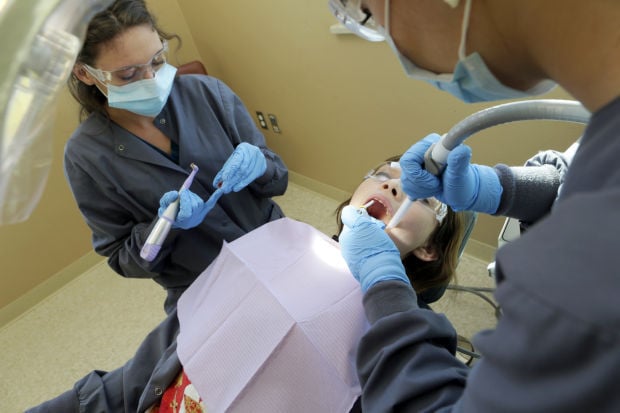Tyler Leo, 17, didn’t cringe when a woman he works with at a local golf course asked him if she had tooth decay.
“It was obvious she did,” Leo said. “It was a little blackish in there — it wasn’t pretty.”
For Leo, it’s another opportunity to exercise what he’s learning in the Marana Unified School District’s dental assistant program.
The dental program, now in its third year, is growing. After two years of class, students test for certifications that qualify them for dental assistant jobs.
“These students are getting national certifications that they can walk in anywhere and get a job,” said Cathie Raymond, Marana’s career and technical education director.
They’re the same certifications sought by trade school and community college students, but at a fraction of the cost. Teens can start in the program during their junior year. The class is held after normal school hours, and meets four days a week.
Students pay about $300 for the program, including purchasing scrubs, an annual course fee and test fees. At Pima Community College, completing a 65-week dental assistant program costs about $6,877, according to the college’s website.
“Saving thousands to get a job out of high school — that’s amazing,” said Toni Yoshinaga, who took her daughter, a Marana High School student, to an open house showcasing the program.
The class is held at the Marana Health Center, which is a five minute drive from the Marana Road exit off Interstate 10. The health center donated the classrooms and practice space for the program. The exam areas, sterilization room and darkroom are equivalent to what is found in a modern dental practice.
Much of the equipment, from the mismatched dental chairs to the lights looming overhead, was donated by other dental professionals.
The Marana program is a satellite of the Pima County Joint Technical Education District. It started in 2012, and has 22 students enrolled this year, almost triple the first year’s class. Students from any Pima County high school can enroll, but the majority come from Marana schools.
“New career and technical education programs take three to five years to build,” Raymond said.
There are two other growing high school dental assistant programs elsewhere in the state, also offered through JTEDs.
More than 100 dental assistant students enrolled at an east-Phoenix-area JTED, doubling the previous year’s class.
“The dental assistant program is one of the fastest-growing programs at EVIT (East Valley Institute of Technology),” said CeCe Todd, a district public information officer.
Districts market the profession’s promising growth and the ability to get a job that pays above minimum wage right out of high school. The U.S. Bureau of Labor Statistics predicts the need for dental assistants will grow by 25 percent in the next 10 years.
A hands-on education
Students in the first-year class learned there’s more to the mouth than a tongue and teeth. Facial, lingual, incisal, occlusal, mesial, distal — those are terms to describe surfaces of a tooth, for example.
Marana High School junior Hailey Albert can construct and deconstruct a syringe without pause and rapidly rattle off the use for an HVE, or high volume evacuator.
“It gets debris and water out of the mouth quicker,” Albert said.
Once they learn basic terminology, students move on to performing X-rays and teeth polishings.
Of the students who have graduated from the Marana program, half have pursued a career in the dental field or gone on to college, Raymond said. Others who started the class as seniors, like Katy Crosswhite, continue to attend the class after graduation to earn their certifications.
Crosswhite, now a freshman at the University of Arizona, aspires to be an orthodontist.
“I might as well get my foot in the door and know if I can tolerate putting my hand in people’s mouths every day,” Crosswhite said.





